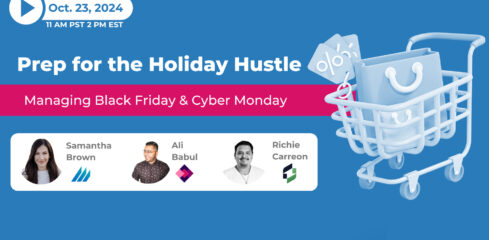Selling on Amazon is a whole new world beyond selling on your webstore. There’s a lot involved in sustaining continuous sales on Amazon beyond just having products listed on the world’s largest marketplace. To set your Amazon business up for success, one of the main areas to focus on is inventory: the flow, the costs, the timing of it all.
Amazon’s recent introduction of low inventory fees is a key development you need to be aware of. These fees penalize sellers for consistently maintaining low stock levels relative to historical sales data.
So, how do you avoid running out of stock? Or getting below the 28 days of historical daily sales threshold? It’s probably easier than you think, but does require some diligence to track and check in on levels. More on that below…
Read more: Replenishment Strategies for FBA: Avoid Amazon’s Low Inventory FeesThis crucial component is often overlooked among exciting advertising and merchandising options, but ensuring you have enough inventory to meet that ongoing demand is important not just for sales, but to stay in good graces with Amazon.
The key to avoiding this lies in a strategic FBA inventory replenishment strategy. By proactively managing your stock levels, you can ensure your products are always available, keeping customers happy, your business thriving on Amazon, and avoiding pesky fees.
Understanding Amazon’s Replenishment Landscape
It’s easy to sign up for the magic of Fulfillment by Amazon (FBA): you send your products to Amazon’s warehouses, and they take care of everything from picking and packing to shipping directly to your customers. Sounds convenient, right?
However, FBA throws a few twists into inventory management. While Amazon handles the logistics, the responsibility of ensuring you have enough stock to meet customer demand falls squarely on you, the seller. And, with fees that penalize the seller for sending in too little, along with fees that get applied for slow-moving stock, this is where a strategic FBA replenishment strategy becomes crucial.
To navigate this landscape effectively, understanding three key metrics is essential:
- Sell-through Rate: This metric reveals the average number of units you sell per specific period (week or month) on specific product SKUs (or ASINs in the Amazon world). Knowing your sell-through rate helps predict future demand and determine how quickly your inventory moves.
- Lead Time: This refers to the time it takes for your order to be placed with your supplier and for the inventory to arrive at an Amazon fulfillment center. Lead time can vary depending on factors like your supplier’s location, manufacturing processes, and even global shipping delays.
- Safety Stock: This buffer inventory acts as a lifeline during unexpected sales surges or unforeseen delays. Having enough safety stock prevents overselling and stockouts and ensures you can continue fulfilling orders even when faced with temporary hiccups.
Building a Replenishment Strategy
Having key data points for sell-through rate and lead time is great, but what do you do with that information? How will this help you to have a well-stocked virtual shelf on Amazon? As selling through FBA, utilizing Amazon’s fulfillment centers, and working within their processes are more complex, a strategic replenishment plan is the key to ensuring your products are always available, preventing stockouts, and maximizing sales.
Here’s how to build a robust replenishment strategy with the right data:
1. Data-driven Decisions
Your historical sales data is a goldmine of insights. Download reports and segment into rolling periods of the 28, 60, and 90-day periods; look at this period over last period and this period over last year’s period (i.e. month over month and month over the same month last year). Analyze it thoroughly to understand your average daily/weekly/monthly sales (sell-through rate) for each product. This data becomes the foundation for forecasting future demand. Then, add your supplier lead times in, as well as time to Amazon’s fulfillment centers to get the full FBA inbound restock timeline to prevent low-inventory fees and stay within ideal stock levels (one to 5 months’ worth).
2. Consider Seasonality
Not all months are created equal. Some products experience significant sales fluctuations throughout the year. Think summer spikes for pool supplies or holiday spikes for toys or winter wear. Ignoring seasonality in your replenishment plan is a recipe for disaster. Factor in historical sales trends beyond the current 30- or 90-day period. Look to last year’s trends and results, match that to the current sales trend and then examine demand planning to adjust your reorder points accordingly.
3. Remember Lead Time
Lead time: we talked about it earlier and it’s worth calling out on its own. This key timing (the time between placing an order and receiving inventory) is crucial. Receiving inventory to your warehouse from suppliers is one thing. Then, when working with Amazon, it’s important to also factor in the additional timeframe to get to Amazon’s fulfillment centers. Miscalculating lead time, whether just to FBA or in from your supplier, can lead to stockouts and lost sales. Consider factors like:
- Supplier location: Overseas suppliers often have longer lead times than domestic ones.
- Manufacturing processes: Complex products might involve longer production times.
- Shipping delays: Whether for global holidays, peak season capacity, or unforeseen delays, allow some buffer time for your deliveries as many things can disrupt your perfectly calculated arrival date.
4. Set Reorder Points
This is where you build in buffer time. Reorder points are thresholds at which you stop selling inventory and start looking into reordering products. This can be done on one sales channel or across all. Setting accurate reorder points allows you to proactively manage those critical moments for when you need to restock your inventory, vs. rushing at the last minute to avoid stockouts. Consider it your pre-determined inventory level at which you trigger a new order. Here’s the formula:
Reorder Point = (Average Daily Sales x Lead Time) + Safety Stock
- Average Daily Sales: This comes from your historical sales data analysis.
- Lead Time: Factor in the time it takes to receive new inventory.
- Safety Stock: This buffer protects you from unexpected demand surges or delays.
Inventory Management Software: Your FBA Replenishment Partner
While the core principles of data analysis, seasonality awareness, lead time consideration, and reorder points form the foundation of a strong FBA replenishment strategy, implementing these strategies effectively can be daunting, especially as your business scales.
This is where sophisticated inventory management software solutions become your secret weapon. Imagine having a powerful partner that streamlines your entire FBA journey, automating tedious tasks and empowering you with the insights needed to make informed decisions.
- Real-time Data Analysis: Constantly monitor inventory levels and sales trends and identify potential stockouts.
- Sales Forecasting: Utilize advanced algorithms to predict future demand based on historical data and seasonal trends.
- Automated Ordering: Set reorder points and automate purchase orders based on calculated lead times and forecasted demand.
- Integration with FBA: Seamlessly connect with Amazon’s system for real-time inventory visibility and efficient shipment management.
Streamline FBA with Finale Inventory
Finale Inventory can streamline your entire FBA process, empowering you with the following:
- Data Analytics at Your Fingertips: Ditch the spreadsheets and manual calculations. Finale Inventory serves as a centralized dashboard that provides a comprehensive view of your inventory performance across Amazon, as well as other marketplaces and webstores. This real-time data empowers you to identify trends, analyze sales velocity, and make data-driven decisions regarding replenishment needs.
- Intelligent Forecasting: Move beyond guesswork. Finale leverages advanced algorithms that analyze historical sales data, factor in seasonality, and account for external influences. This enables you to predict future demand with exceptional accuracy, minimizing the risk of stockouts and ensuring you have the right amount of inventory to meet customer needs. Further, you can receive reorder notifications, ensuring you never miss a beat on the business.
- Automated Replenishment: Say goodbye to manual order placement. Finale enables businesses to set up automatic reorder points based on your calculated lead time and forecasted demand. The software will then automatically trigger purchase orders to your suppliers, ensuring a steady flow of inventory without the need for constant monitoring.
- Effortless Integration with FBA: Seamlessly connect Finale Inventory with Amazon’s system for real-time inventory visibility. This eliminates the need for manual data entry and ensures efficient shipment management, allowing you to focus on growing your business.
By incorporating these replenishment strategies for FBA, Finale Inventory becomes your trusted partner in navigating the complexities of FBA inventory management.
Ready to streamline your FBA experience and regain control of your stock levels? Explore how Finale Inventory can empower you to build a winning replenishment strategy and watch your Amazon business soar.







